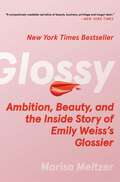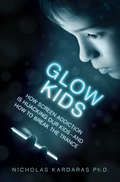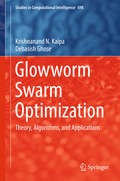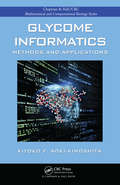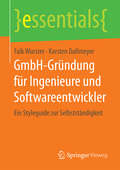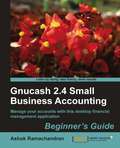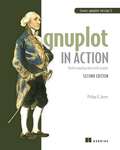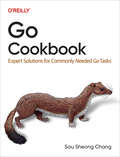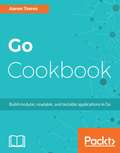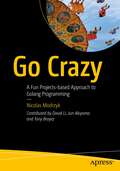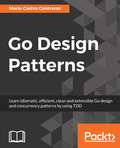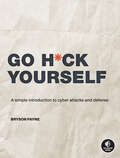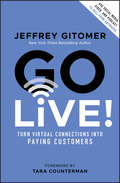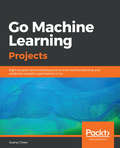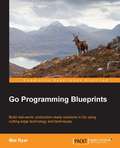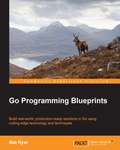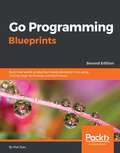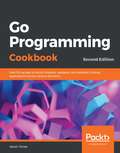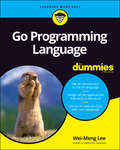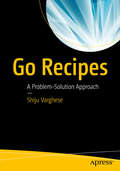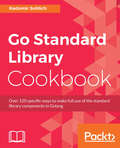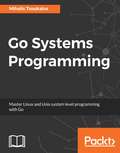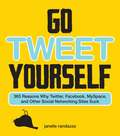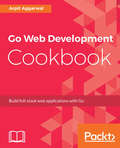- Table View
- List View
Glossy: Ambition, Beauty, and the Inside Story of Emily Weiss's Glossier
by Marisa MeltzerINSTANT NEW YORK TIMES BESTSELLER • Financial Times Best Book of the Year The &“compulsively readable narrative of beauty, business, privilege, and mogul-dom&” (The New York Times) that reveals—for the first time—exactly wat happened at Glossier, one of America&’s hottest and most consequential startups, and dives deep into the enigmatic, visionary woman responsible for it all.Called &“one of the most disruptive brands in beauty&” by Forbes, Glossier revolutionized the beauty industry with its sophisticated branding and unique approach to influencer marketing, almost instantly making the company a juggernaut with rabid fans. It also taught a generation of business leaders how to talk to Millennial and Gen Z customers and build a cult following online. At the center of the story lies Emily Weiss, the elusive former Teen Vogue &“superintern&” on the reality show The Hills turned Into the Gloss beauty blogger who had the vision, guts, and searing ambition needed to launch Glossier. She cannily turned every experience, every meeting into an opportunity to fuel her own personal success. Together with her expensive, signature style and singular vision for the future of consumerism, she could not be stopped. Just how did a girl from suburban Connecticut with no real job experience work her way into the bathrooms and boudoirs of the most influential names in the world and build that access into a 1.9-billion-dollar business? Is she solely responsible for its success? And why, eight years later, at the height of Glossier mania, did she step down? In Glossy, journalist and author Marisa Meltzer combines in-depth interviews with former Glossier employees, investors, and Weiss herself to bring you inside the walls of this fascinating and secretive company. From fundraising to product launches and unconventional hiring practices, Meltzer exposes the inner workings of Glossier&’s culture, culminating in the story of Weiss herself. The Devil Wears Prada for the Bad Blood generation, Glossy is not just a gripping portrait of one of the most important business leaders of her generation, but also a chronicle of an era.
Glow Kids: How Screen Addiction Is Hijacking Our Kids - and How to Break the Trance
by Nicholas KardarasWe've all seen them: kids hypnotically staring at glowing screens in restaurants, in playgrounds and in friends' houses--and the numbers are growing. Like a virtual scourge, the illuminated glowing faces--the Glow Kids--are multiplying. But at what cost? Is this just a harmless indulgence or fad like some sort of digital hula-hoop? Some say that glowing screens might even be good for kids--a form of interactive educational tool. Don't believe it. In Glow Kids, Dr. Nicholas Kardaras will examine how technology--more specifically, age-inappropriate screen tech, with all of its glowing ubiquity--has profoundly affected the brains of an entire generation. Brain imaging research is showing that stimulating glowing screens are as dopaminergic (dopamine activating) to the brain's pleasure center as sex. And a growing mountain of clinical research correlates screen tech with disorders like ADHD, addiction, anxiety, depression, increased aggression, and even psychosis. Most shocking of all, recent brain imaging studies conclusively show that excessive screen exposure can neurologically damage a young person's developing brain in the same way that cocaine addiction can. Kardaras will dive into the sociological, psychological, cultural, and economic factors involved in the global tech epidemic with one major goal: to explore the effect all of our wonderful shiny new technology is having on kids. Glow Kids also includes an opt-out letter and a "quiz" for parents in the back of the book.
Glowworm Swarm Optimization
by Krishnanand N. Kaipa Debasish GhoseThis book provides a comprehensive account of the glowworm swarm optimization (GSO) algorithm, including details of the underlying ideas, theoretical foundations, algorithm development, various applications, and MATLAB programs for the basic GSO algorithm. It also discusses several research problems at different levels of sophistication that can be attempted by interested researchers. The generality of the GSO algorithm is evident in its application to diverse problems ranging from optimization to robotics. Examples include computation of multiple optima, annual crop planning, cooperative exploration, distributed search, multiple source localization, contaminant boundary mapping, wireless sensor networks, clustering, knapsack, numerical integration, solving fixed point equations, solving systems of nonlinear equations, and engineering design optimization. The book is a valuable resource for researchers as well as graduate and undergraduate students in the area of swarm intelligence and computational intelligence and working on these topics.
Glut: Mastering Information through the Ages
by Alex WrightWhat do primordial bacteria, medieval alchemists, and the World Wide Web have to do with each other? This fascinating exploration of how information systems emerge takes readers on a provocative journey through the history of the information age. Today's "information explosion" may seem like an acutely modern phenomenon, but we are not the first generation--nor even the first species--to wrestle with the problem of information overload. Long before the advent of computers, human beings were collecting, storing, and organizing information: from Ice Age taxonomies to Sumerian archives, Greek libraries to Dark Age monasteries. Today, we stand at a precipice, as our old systems struggle to cope with what designer Richard Saul Wurman called a "tsunami of data." With some historical perspective, however, we can begin to understand our predicament not just as the result of technological change, but as the latest chapter in an ancient story that we are only beginning to understand. Spanning disciplines from evolutionary theory and cultural anthropology to the history of books, libraries, and computer science, writer and information architect Alex Wright weaves an intriguing narrative that connects such seemingly far-flung topics as insect colonies, Stone Age jewelry, medieval monasteries, Renaissance encyclopedias, early computer networks, and the World Wide Web. Finally, he pulls these threads together to reach a surprising conclusion, suggesting that the future of the information age may lie deep in our cultural past.
Glycome Informatics: Methods and Applications (Chapman And Hall/crc Computational Biology Ser.)
by Kiyoko F. Aoki-KinoshitaA Focused, State-of-the-Art Overview of This Evolving FieldPresents Various Techniques for GlycoinformaticsThe development and use of informatics tools and databases for glycobiology and glycomics research have increased considerably in recent years. In addition to accumulating well-structured glyco-related data, researchers have now developed semi
GmbH-Gründung für Ingenieure und Softwareentwickler: Ein Styleguide zur Selbstständigkeit (essentials)
by Falk Wurster Karsten DallmeyerDieses essential beschreibt den Ablauf einer erfolgreichen GmbH-Gründung aus der Perspektive von Softwareingenieuren. Im Vergleich zu anderen Start-up-Sachbüchern werden Strategien und mögliche Lösungswege anhand von Analogien zur Softwarearchitektur aufgezeigt. Der Schwerpunkt liegt dabei vor allem auf der Planung und Spezifikation in der Vorbereitungsphase. Entlang des roten Fadens der Gründungsvorbereitung und Nachgründungsphase werden wichtige Aspekte und Abhängigkeiten zur Entscheidungsfindung beschrieben. Das essential ist keine Ansammlung trockener Checklisten, sondern begleitet unterhaltsam und praxisnah auf dem Weg in die Selbstständigkeit.
Gnucash 2.4 Small Business Accounting: Beginner's Guide
by Ashok RamachandranThis book is a comprehensive beginner's guide that teaches you to use GnuCash from scratch with jargon-free step-by-step tutorials packed with tips. There are multiple choice questions to make learning more interesting and additional challenges thrown at the more adventurous user for a deep grasp of the topic.This book is written for you - the self-employed, the owner, partner or leader of micro-enterprises, home businesses, Small Office/Home Office (SOHO), and other small businesses - to help you maintain your books of accounts using GnuCash. This book is also for you - office-bearers of non-profits and students who want to learn accounting hands-on. If you are using a spreadsheet to maintain your business books and are wasting time, or you are handing over a shoe box of receipts to your high-priced accountant or are using another accounting application that is overkill for small business, get this book and download GnuCash.
Gnuplot in Action: Understanding data with graphs
by Philipp K. JanertSummaryGnuplot in Action, Second Edition is a major revision of this popular and authoritative guide for developers, engineers, and scientists who want to learn and use gnuplot effectively. Fully updated for gnuplot version 5, the book includes four pages of color illustrations and four bonus appendixes available in the eBook.Purchase of the print book includes a free eBook in PDF, Kindle, and ePub formats from Manning Publications.About the TechnologyGnuplot is an open-source graphics program that helps you analyze, interpret, and present numerical data. Available for Unix, Mac, and Windows, it is well-maintained, mature, and totally free.About the BookGnuplot in Action, Second Edition is a major revision of this authoritative guide for developers, engineers, and scientists. The book starts with a tutorial introduction, followed by a systematic overview of gnuplot's core features and full coverage of gnuplot's advanced capabilities. Experienced readers will appreciate the discussion of gnuplot 5's features, including new plot types, improved text and color handling, and support for interactive, web-based display formats. The book concludes with chapters on graphical effects and general techniques for understanding data with graphs. It includes four pages of color illustrations. 3D graphics, false-color plots, heatmaps, and multivariate visualizations are covered in chapter-length appendixes available in the eBook.What's InsideCreating different types of graphs in detailAnimations, scripting, batch operationsExtensive discussion of terminalsUpdated to cover gnuplot version 5About the ReaderNo prior experience with gnuplot is required. This book concentrates on practical applications of gnuplot relevant to users of all levels.About the AuthorPhilipp K. Janert, PhD, is a programmer and scientist. He is the author of several books on data analysis and applied math and has been a gnuplot power user and developer for over 20 years.Table of ContentsPART 1 GETTING STARTEDPrelude: understanding data with gnuplotTutorial: essential gnuplotThe heart of the matter: the plot commandPART 2 CREATING GRAPHSManaging data sets and filesPractical matters: strings, loops, and historyA catalog of stylesDecorations: labels, arrows, and explanationsAll about axesPART 3 MASTERING TECHNICALITIESColor, style, and appearanceTerminals and output formatsAutomation, scripting, and animationBeyond the defaults: workflow and stylesPART 4 UNDERSTANDING DATABasic techniques of graphical analysisTopics in graphical analysisCoda: understanding data with graphs
Go Cookbook: Expert Solutions for Commonly Needed Go Tasks
by Sau Sheong ChangGo is an increasingly popular language for programming everything from web applications to distributed network services. This practical guide provides recipes to help you unravel common problems and perform useful tasks when working with Go. Each recipe includes self-contained code solutions that you can freely use, along with a discussion of how and why they work. Programmers new to Go can quickly ramp up their knowledge while accomplishing useful tasks, and experienced Go developers can save time by cutting and pasting proven code directly into their applications.Recipes include:Creating a moduleCalling code from another moduleReturning and handling an errorConverting strings to numbers (or converting numbers to strings)Modifying multiple characters in a stringCreating substrings from a stringCapturing string inputAnd so much more
Go Cookbook: Over 85 Recipes To Build Modular, Readable, And Testable Golang Applications Across Various Domains, 2nd Edition
by Aaron TorresBridge the gap between basic understanding of Go and use of its advanced features About This Book • Discover a number of recipes and approaches to develop modern back-end applications • Put to use the best practices to combine the recipes for sophisticated parallel tools • This book is based on Go 1.8, which is the latest version Who This Book Is For This book is for web developers, programmers, and enterprise developers. Basic knowledge of the Go language is assumed. Experience with back-end application development is not necessary, but may help understand the motivation behind some of the recipes. What You Will Learn • Test your application using advanced testing methodologies • Develop an awareness of application structures, interface design, and tooling • Create strategies for third-party packages, dependencies, and vendoring • Get to know tricks on treating data such as collections • Handle errors and cleanly pass them along to calling functions • Wrap dependencies in interfaces for ease of portability and testing • Explore reactive programming design patterns in Go In Detail Go (a.k.a. Golang) is a statically-typed programming language first developed at Google. It is derived from C with additional features such as garbage collection, type safety, dynamic-typing capabilities, additional built-in types, and a large standard library. This book takes off where basic tutorials on the language leave off. You can immediately put into practice some of the more advanced concepts and libraries offered by the language while avoiding some of the common mistakes for new Go developers. The book covers basic type and error handling. It explores applications that interact with users, such as websites, command-line tools, or via the file system. It demonstrates how to handle advanced topics such as parallelism, distributed systems, and performance tuning. Lastly, it finishes with reactive and serverless programming in Go. Style and approach This guide is a handy reference for developers to quickly look up Go development patterns. It is a companion to other resources and a reference that will be useful long after reading it through the first time. Each recipe includes working, simple, and tested code that can be used as a reference or foundation for your own applications.
Go Crazy: A Fun Projects-based Approach to Golang Programming
by Nicolas ModrzykGo beyond the basics of Go and build complete applications using open-source libraries or the Go programming language by Google. This book will take you deep into the memory lane of the Go language with crunchy details straight from outer space.The applications in this book include the framework for a 2D Go-based game, an image random generator Rest API, financial time series handling for trading, a Kubernetes operator, a Blockchain coding and more. You'll also get refreshers on Go constructs and useful code tricks to build performant projects, and develop an HTTP based cloud ready image generator. Each chapter will be organized in the following format: what the particular application looks like; requirements and user stories of our example program; an introduction to the Go libraries or frameworks used; and the actual implementation of the example program, including common pitfalls and their solutions. Go Crazy will open your eyes to a new world of practical applications for Go. After reading the book, you will be able to apply your Golang knowledge to build your own crazy projects. Free source code will be available on this book's Apress GitHub page. What You'll Learn Compile and inline other programming languages, including GPU coding.Handle Kubernetes clusters via your own operator Write Go to code against Ethereum based block chains. Write intelligent bot code to get you rich and famous. Who This Book Is ForGo programmers both experienced and novice.
Go Design Patterns
by Mario Castro ContrerasThe target audience is both beginner- and advanced-level developers in the Go programming language. No knowledge of design patterns is expected.
Go H*ck Yourself: A Simple Introduction to Cyber Attacks and Defense
by Bryson PayneLearn firsthand just how easy a cyberattack can be.Go H*ck Yourself is an eye-opening, hands-on introduction to the world of hacking, from an award-winning cybersecurity coach. As you perform common attacks against yourself, you&’ll be shocked by how easy they are to carry out—and realize just how vulnerable most people really are.You&’ll be guided through setting up a virtual hacking lab so you can safely try out attacks without putting yourself or others at risk. Then step-by-step instructions will walk you through executing every major type of attack, including physical access hacks, Google hacking and reconnaissance, social engineering and phishing, malware, password cracking, web hacking, and phone hacking. You&’ll even hack a virtual car! You&’ll experience each hack from the point of view of both the attacker and the target. Most importantly, every hack is grounded in real-life examples and paired with practical cyber defense tips, so you&’ll understand how to guard against the hacks you perform.You&’ll learn: • How to practice hacking within a safe, virtual environment • How to use popular hacking tools the way real hackers do, like Kali Linux, Metasploit, and John the Ripper • How to infect devices with malware, steal and crack passwords, phish for sensitive information, and more • How to use hacking skills for good, such as to access files on an old laptop when you can&’t remember the password • Valuable strategies for protecting yourself from cyber attacksYou can&’t truly understand cyber threats or defend against them until you&’ve experienced them firsthand. By hacking yourself before the bad guys do, you&’ll gain the knowledge you need to keep you and your loved ones safe.
Go Live!: Turn Virtual Connections into Paying Customers
by Jeffrey GitomerLearn how to go online with a winning sales and marketing strategy in this insightful resource Go Live! Turn Virtual Connections into Paying Customers helps readers understand and take advantage of several online tools to boost their sales and increase their revenue. Accomplished salesperson, consultant, and online personality Jeffrey Gitomer describes how tools like Facebook Live and podcasting can drive sales and help you connect with your customers. You'll discover: How to use tools like YouTube, LinkedIn Live, podcasting, and Facebook Live to connect with and develop your leads How to properly utilize social media like Instagram and Twitter to spread your message and sell to clients How to promote and repurpose content to create as big an impact on your audience as possible Written specifically for a post-pandemic sales audience, Go Live! Turn Virtual Connections into Paying Customers delivers results for anyone expected to deliver sales results in a virtual environment. It also belongs on the bookshelves of those who hope to take their successful offline sales strategies to the online world.
Go Machine Learning Projects: Eight Projects Demonstrating End-to-end Machine Learning And Predictive Analytics Applications In Go
by Xyanyi ChewThis book would appeal to machine learning engineers, data analysts or developers who have basic knowledge of Golang and essential understanding of machine learning. This book is perfect for readers who want to get machine learning into their real-world projects and make the application much smarter with comfort.
Go Programming Blueprints
by Mat RyerIntended for seasoned Go programmers who want to put their expertise in Go to use to solve big, real-world, modern problems. With a basic understanding of channels and goroutines, you will hone your skills to build tools and programs that are quick and simple. You need not be an expert in distributed systems or technologies in order to deliver solutions capable of great scale. It is assumed that you are familiar with the basic concepts of Go.
Go Programming Blueprints
by Mat Ryer<P><P>Key Features <P><P>Learn to apply the nuances of the Go language, and get to know the open source community that surrounds it to implement a wide range of start-up quality projects <P><P>Write interesting, and clever but simple code, and learn skills and techniques that are directly transferrable to your own projects <P><P>Discover how to write code capable of delivering massive world-class scale performance and availability <P><P>Book Description <P><P>Dive headfirst into solving actual enterprise problems and start cutting code from the word go. You will build complete applications around a variety of subjects using a range of different technologies and techniques, all of which are directly applicable to today's tech start-up world. <P><P>Scale, performance, and high availability lie at the heart of the projects, and the lessons learned throughout this book will arm you with everything you need to build world-class solutions. Well-designed applications and sensible architectures can scale horizontally to cope with the demands of up to millions of users, while avoiding the prohibitive up-front investment that can bring a project to its knees. <P><P>What you will Learn <P><P>Build quirky and fun projects from scratch while exploring widely applicable skills, patterns, practices, and techniques, as well as a range of different technologies <P><P>Create websites and data services capable of massive scale using <P><P>Go's net/http package, exploring RESTful patterns as well as low-latency WebSocket APIs <P><P>Interact with a variety of remote web services to consume capabilities ranging from authentication and authorization to a fully functioning thesaurus <P><P>Develop high-quality command-line tools that utilize the powerful shell capabilities and have great performance using Go's in-built concurrency mechanisms <P><P>Implement a modern document database as well as high-throughput messaging queue technology to put together an architecture that is truly ready for scale <P><P>Write concurrent programs and gracefully manage their execution and communication with smart use of channels
Go Programming Blueprints - Second Edition
by Mat RyerBuild real-world, production-ready solutions in Go using cutting-edge technology and techniques About This Book * Get up to date with Go and write code capable of delivering massive world-class scale performance and availability * Learn to apply the nuances of the Go language, and get to know the open source community that surrounds it to implement a wide range of start-up quality projects * Write interesting and clever but simple code, and learn skills and techniques that are directly transferrable to your own projects Who This Book Is For If you are familiar with Go and are want to put your knowledge to work, then this is the book for you. Go programming knowledge is a must. What You Will Learn * Build quirky and fun projects from scratch while exploring patterns, practices, and techniques, as well as a range of different technologies * Create websites and data services capable of massive scale using Go's net/http package, exploring RESTful patterns as well as low-latency WebSocket APIs * Interact with a variety of remote web services to consume capabilities ranging from authentication and authorization to a fully functioning thesaurus * Develop high-quality command-line tools that utilize the powerful shell capabilities and perform well using Go's in-built concurrency mechanisms * Build microservices for larger organizations using the Go Kit library * Implement a modern document database as well as high-throughput messaging queue technology to put together an architecture that is truly ready to scale * Write concurrent programs and gracefully manage the execution of them and communication by smartly using channels * Get a feel for app deployment using Docker and Google App Engine In Detail Go is the language of the Internet age, and the latest version of Go comes with major architectural changes. Implementation of the language, runtime, and libraries has changed significantly. The compiler and runtime are now written entirely in Go. The garbage collector is now concurrent and provides dramatically lower pause times by running in parallel with other Go routines when possible. This book will show you how to leverage all the latest features and much more. This book shows you how to build powerful systems and drops you into real-world situations. You will learn to develop high-quality command-line tools that utilize the powerful shell capabilities and perform well using Go's in-built concurrency mechanisms. Scale, performance, and high availability lie at the heart of our projects, and the lessons learned throughout this book will arm you with everything you need to build world-class solutions. You will get a feel for app deployment using Docker and Google App Engine. Each project could form the basis of a start-up, which means they are directly applicable to modern software markets. Style and approach This book provides fun projects that involve building applications from scratch. These projects will teach you to build chat applications, a distributed system, and a recommendation system.
Go Programming Cookbook: Over 85 recipes to build modular, readable, and testable Golang applications across various domains, 2nd Edition
by Aaron TorresTackle the trickiest of problems in Go programming with this practical guide Key Features Develop applications for different domains using modern programming techniques Tackle common problems when it comes to parallelism, concurrency, and reactive programming in Go Work with ready-to-execute code based on the latest version of Go Book Description Go (or Golang) is a statically typed programming language developed at Google. Known for its vast standard library, it also provides features such as garbage collection, type safety, dynamic-typing capabilities, and additional built-in types. This book will serve as a reference while implementing Go features to build your own applications. This Go cookbook helps you put into practice the advanced concepts and libraries that Golang offers. The recipes in the book follow best practices such as documentation, testing, and vendoring with Go modules, as well as performing clean abstractions using interfaces. You'll learn how code works and the common pitfalls to watch out for. The book covers basic type and error handling, and then moves on to explore applications, such as websites, command-line tools, and filesystems, that interact with users. You'll even get to grips with parallelism, distributed systems, and performance tuning. By the end of the book, you'll be able to use open source code and concepts in Go programming to build enterprise-class applications without any hassle. What you will learn Work with third-party Go projects and modify them for your use Write Go code using modern best practices Manage your dependencies with the new Go module system Solve common problems encountered when dealing with backend systems or DevOps Explore the Go standard library and its uses Test, profile, and fine-tune Go applications Who this book is for If you're a web developer, programmer, or enterprise developer looking for quick solutions to common and not-so-common problems in Go programming, this book is for you. Basic knowledge of the Go language is assumed.
Go Programming Language For Dummies
by Wei-Meng LeeReady, set, program with Go! Now is the perfect time to learn the Go Programming Language. It’s one of the most in-demand languages among tech recruiters and developers love its simplicity and power. Go Programming Language For Dummies is an easy way to add this top job skill to your toolkit. Written for novice and experienced coders alike, this book traverses basic syntax, writing functions, organizing data, building packages, and interfacing with APIs. Go—or GoLang, as it’s also known—has proven to be a strong choice for developers creating applications for the cloud-based world we live in. This book will put you on the path to using the language that’s created some of today’s leading web applications, so you can steer your career where you want to Go! Learn how Go works and start writing programs and modules Install and implement the most powerful third-party Go packages Use Go in conjunction with web services and MySQL databases Keep your codebase organized and use Go to structure data With this book, you can join the growing numbers of developers using Go to create 21st century solutions. Step inside to take start writing code that puts data in users’ hands.
Go Recipes
by Shiju VargheseSolve your Go problems using a problem-solution approach. Each recipe is a self-contained answer to a practical programming problem in Go. Go Recipes contains recipes that deal with the fundamentals of Go, allowing you to build simple, reliable, and efficient software. Other topics include working with data using modern NoSQL databases such as MongoDB and RethinkDB. The book provides in-depth guidance for building highly scalable backend APIs in Go for your mobile client applications and web client applications. All this means that you’ll be able to write programs that get the most out of multicore and networked machines, using Go’s novel type system that enables flexible and modular program construction. You'll see how to test your Go applications so they are ready for deployment, as well as learning how to write HTTP servers to offer you maximum flexibility when dealing with remote clients.What You'll LearnWork with the core fundamentals of GoPersist data into NoSQL databasesBuild scalable backend APIsTest your Go applicationsCreate HTTP web servers in GoWho This Book Is ForExperienced programmers who have some or no prior experience with Go.
Go Standard Library Cookbook: Over 120 specific ways to make full use of the standard library components in Golang
by Radomír SohlichImplement solutions by leveraging the power of the GO standard library and reducing dependency on external crates Key Features Develop high quality, fast and portable applications by leveraging the power of Go Standard Library. Practical recipes that will help you work with the standard library algorithms to boost your productivity as a Go developer. Compose your own algorithms without forfeiting the simplicity and elegance of the Standard Library. Book Description Google's Golang will be the next talk of the town, with amazing features and a powerful library. This book will gear you up for using golang by taking you through recipes that will teach you how to leverage the standard library to implement a particular solution. This will enable Go developers to take advantage of using a rock-solid standard library instead of third-party frameworks. The book begins by exploring the functionalities available for interaction between the environment and the operating system. We will explore common string operations, date/time manipulations, and numerical problems. We'll then move on to working with the database, accessing the filesystem, and performing I/O operations. From a networking perspective, we will touch on client and server-side solutions. The basics of concurrency are also covered, before we wrap up with a few tips and tricks. By the end of the book, you will have a good overview of the features of the Golang standard library and what you can achieve with them. Ultimately, you will be proficient in implementing solutions with powerful standard libraries. What you will learn Access environmental variables Execute and work with child processes Manipulate strings by performing operations such as search, concatenate, and so on Parse and format the output of date/time information Operate on complex numbers and effective conversions between different number formats and bases Work with standard input and output Handle filesystem operations and file permissions Create TCP and HTTP servers, and access those servers with a client Utilize synchronization primitives Test your codeWho this book is for This book is for Go developers who would like to explore the power of Golang and learn how to use the Go standard library for various functionalities. The book assumes basic Go programming knowledge.
Go Systems Programming
by Mihalis TsoukalosIntermediate Linux and general UNIX programmers. Network programmers from beginners to advanced practitioners. C and C++ programmers interested in different approaches to concurrency and Linux systems programming.
Go Tweet Yourself: 365 Reasons Why Twitter, Facebook, MySpace, and Other Social Networking Sites Suck
by Janelle RandazzaFlip Twitter the bird.Tell Facebook to f#@% off.Lose it on LinkedIn.Somewhere between the advent of Facebook and launching Twitter to the masses, the Internet betrayed us. It allowed pages to be viewed by job interviewers, newsfeeds to be flooded by Aunt Julie, and for constant tweets about what color socks that random girl from the study group is going to wear today.This book is the hilarious reply all that says: enough is enough. We don’t want to see the pictures from your business trip to Omaha. We don’t want a page-by-page account of what’s going on in Twilight. We definitely don’t want a virtual drink!When you can’t fix the problem, fix the blame. And since there’s no way in 2.0-hell that you can put an end to the bastardization of the Book, you may as well have a good laugh while pointing the finger at those who ruined their online experience.
Go Web Development Cookbook: Build full-stack web applications with Go
by Arpit Aggarwal86 recipes on how to build fast, scalable, and powerful web services and applications with GoKey FeaturesBecome proficient in RESTful web servicesBuild scalable, high-performant web applications in GoGet acquainted with Go frameworks for web developmentBook DescriptionGo is an open source programming language that is designed to scale and support concurrency at the language level. This gives you the liberty to write large concurrent web applications with ease. From creating web application to deploying them on Amazon Cloud Services, this book will be your one-stop guide to learn web development in Go. The Go Web Development Cookbook teaches you how to create REST services, write microservices, and deploy Go Docker containers. Whether you are new to programming or a professional developer, this book will help get you up to speed with web development in Go. We will focus on writing modular code in Go; in-depth informative examples build the base, one step at a time. You will learn how to create a server, work with static files, SQL, NoSQL databases, and Beego. You will also learn how to create and secure REST services, and create and deploy Go web application and Go Docker containers on Amazon Cloud Services. By the end of the book, you will be able to apply the skills you've gained in Go to create and explore web applications in any domain.What you will learn Create a simple HTTP and TCP web server and understand how it works Explore record in a MySQL and MongoDB database Write and consume RESTful web service in Go Invent microservices in Go using Micro – a microservice toolkit Create and Deploy the Beego application with Nginx Deploy Go web application and Docker containers on an AWS EC2 instanceWho this book is forThis book is for Go developers interested in learning how to use Go to build powerful web applications. A background in web development is expected.
